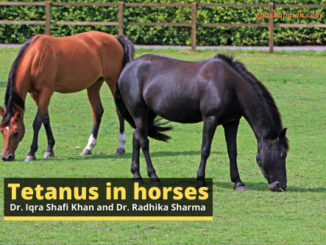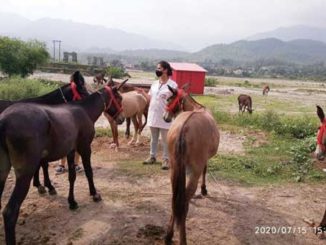Introduction
Basic requirements of horses are shelter, feed, water, grooming, waste removal and exercise that will be discussed in this article.
Shelter management
- Loose box should be 10’x10’ (3mx3m) to 12’x12’ (3.6mx3.6m) or 14’x14’ for an average size riding horse.
- Larger horses will appreciate the extra room to move around.
- Box measuring 12x10ft is suitable for pony.
- 12x12ft for horses from 14.2-16.2hh.
- 12x14ft or 14x14ft for horses over 16.2hh.
- 16x16ft for very large horses or for foaling.
- Doorways should be 4ft wide.
- Horses of 14.2hh and above will usually have a bottom door 4ft high with a top door of 3ft (total doorway height of 7ft).
- Although the recommended size for a foaling stall is the same as a regular stall.
- Easiest way to provide roomy accommodations for mares and foals is to take partitions out between two regular stalls.
- So you don’t have to build a stall specifically to be a foaling stall.
Standing or Tie Stalls
- Standing or tie stalls need to be wide enough for a horse to lie down in comfortably.
- Depending on the size of the horse, they should be at least 4ft or 5ft (1.5m) wide and 8ft (2.4m) long.
- There is usually a manger for hay at the front of a standing stall, so the width of this should be considered.
- Pony will need a shorter and narrower standing stall than a larger draft breed, which again will need more space.
- In both standing and box stalls, the walls should be solid, sturdy lumber to a tleast 4.6ft (1.4m) high, and above that, grill or sturdy mesh so that horses can see each other.
- This also helps with ventilation and light.
Stall Doors
- Stall doors can be either swinging or sliding.
- Swinging doors should open out into the alley, and be kept shut at all other times
- They should fasten securely shut so horses don’t escape.
- Sliding doors should slide smoothly.
- Grain room doors should be locked.
- Doors should be at least 4ft (1.2m) wide.
Flooring
- Most commonly used flooring in stables is concrete.
- If the surface is roughened, it is non-slip, concrete, pavers, or stone floors will not drain naturally, and drains may have to be placed in stalls.
- Many stables do not have drainage.
- This means stalls must be well cleaned to avoid ammonia build up.
- Hard flooring such as pavers or concrete are also easier to disinfect and can be housed down if necessary.
- These floors are harder on a horse’s legs though.
- Many people put stall mats made of rubber like material under the bedding for greater comfort.
- If you have sandy soil, you may decide to leave the earth and not lay down a solid floor.
- This flooring is easier on the horse’s legs and may be warmer and quieter than an un-mated solid floor.
- Earth floors are harder to clean and will need digging out and replacing if the dirt becomes too saturated with urine and water.
Ceilings
- Ceiling height should allow the horse to raise its head comfortably without worrying about hitting the ceiling.
- Standard room height of 8ft (2.4m) might be fine for ponies and small horses, but taller horses will need higher ceilings, also make sure that hanging light fixtures if are unprotected, or other obstructions that horse could hit accidentally when it raises its head, must be taken into consideration.
Lighting
- All lighting and wiring should be installed with safety in mind.
- All plug-ins in stables should be GFIC receptacles, and wiring should be rodent and moisture-proof.
- Fluorescent bulbs may not work well in extreme cold.
- There should be safety cages around light bulbs, and they should be placed where horses cannot reach them.
- Switches should be well out of reach of curious horses.
- Work areas, tack and feed rooms should be well light for safety.
Windows
- Windows provide natural ventilation and lighting.
- Incorporate as many as possible in your stable design.
- They should be covered with a grill or mesh so horses cannot break the glass.
- Windows that swing open may work better over the long run that sliders that tend to fill with dirt and chaff making them stick.
Feeding
- Horses can consume about 2.5 percent of their body weight per day.
- As an animal that evolved as a nibbler and grazer, it is best to feed horses smaller quantities of feed, especially concentrate, at least twice per day at about 12-hour intervals.
- That means a 1,000-pound (500kg) horse will eat about 25 pounds (12.5kg) of feed per day of which at least half should be forage (pasture, hay, or hay cubes).
Water
- Clean, fresh water, and trace-mineralized salt should be available regularly or on a free-choice basis on pasture or in the barn.
- The average 1000-pound adult horse can easily drink 10 to 12 gallons of water a day.
- Horses will suffer more quickly from a lack of water or salt than if they are forced to go without feed.
Feeding and Watering Equipment
- You will need to decide how you will water your horses when they are stabled.
- Most economical option is a bucket hung upon the wall.
- Buckets on the floor can get knocked by the horses.
- In the winter, heated buckets keep the water free of ice.
- A bucket on the wall can suffice for feeding concentrates out of, or you can purchase wall mounted feeding tubs.
- Hay can be served in the mangers.
- Mangers need to be deep enough to hold the hay and have no gaps that horses could catch legs in if they lay down beside it.
- They also need to be easy to clean.
Grazing and Open space
- Many horses are turned out into fields to graze, exercise, or exhibit other natural behavior’s, either on their own or more usually as part of a herd, where they may also engage in play activity and social bonding.
- The area where the horses are placed can be of any size, from a small pen with room to run, to wide areas covering thousands of square miles.
Daily Maintenance
- Grooming, waste removal, and exercise need to be done regularly for your horse to maintain good health.
- To do an adequate job, you will need: brushes, towels, combs, currycombs, hoof picks, manure forks, shovels, rakes, a wheelbarrow, manure spreader, a bridle, saddle, saddle pad, halters, lead rope, and lunge line.
Grooming
- It serves two functions: it removes excess dirt and hair to produce a better coat and circulation.
- It gives you a chance to inspect your animal for injuries, swelling and abnormalities.
- Begin grooming by loosening dirt with a rubber currycomb used in a circular motion, this will provides massage for the horse, as well as a method of dirt removal.
- Because the rubber currycomb is hard, it should be used only above the knees and hocks, and not on the face.
- The next step is to use a stiff brush (Dandy brush) to remove the loosened dirt.
- Brush briskly in the direction of the hair, with a “flicking” motion to remove the dirt and debris from the hair coat.
- Continue by going over the animal once again with a soft brush, stroking with the grain of the hair, and then towel off the excess dust.
- Use a hoof pick to remove any dirt or stones from the animal’s feet and finish by combing out the mane and tail.
Waste Removal
- Cleaning stalls can be an important part of your daily aerobic exercise.
- Horses kept, or fed, inside should have their stalls cleaned once a day.
- Do not remove all of the bedding, just the soiled or wet bedding and manure.
- Manure should be removed from pastures periodically.
Exercise
- Exercise for the horse takes various forms.
- Riding, driving, lungeing, and turning out the animal are all satisfactory methods.
- If your horse is kept outdoors, it will exercise to some degree by walking around. However, stalled horses should be out for at least 60 minutes each day.
- Never allow your horse to eat a meal or drink unlimited water immediately after exercising because this can cause colic or founder.
Sand bath
- To make relax the horses, sand bath is necessary for the horses, where they could relax.






Be the first to comment